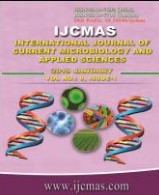


 National Academy of Agricultural Sciences (NAAS)
National Academy of Agricultural Sciences (NAAS)

|
PRINT ISSN : 2319-7692
Online ISSN : 2319-7706 Issues : 12 per year Publisher : Excellent Publishers Email : editorijcmas@gmail.com / submit@ijcmas.com Editor-in-chief: Dr.M.Prakash Index Copernicus ICV 2018: 95.39 NAAS RATING 2020: 5.38 |
The study was undertaken to compare the effect of tray and solar drying on the quality attributes of pineapple powder and its storability in different packaging materials. For the study, pineapple slices were first subjected to osmotic dehydration process using sugar syrup of 60 oBrix for 12 hours at room temperature. Powder was prepared after solar (using natural solar cabinet dryer) and tray drying (at 50, 60, 70 and 80 oC) of pineapple slices. The pineapple powder was analyzed for physical (particle size, bulk density, color); chemical (moisture, protein, fat, carbohydrate, ascorbic acid); physico-chemical (water activity (aw), solubility, hygroscopicity), microbial and organoleptic evaluation. Pineapple powder prepared at tray drying temperature of 60 oC was of best quality among different temperatures range and hence was selected for storage studies. The particle size and colour changed significantly during storage period (6 months); however the changes in bulk density and water activity were insignificant. Solubility and hygroscopicity of the pineapple powder decreased significantly while the microbial load (total plate count, yeasts and moulds) increased significantly during storage. The proximate composition of the powder did not change significantly during storage period. The sensory attributes (colour, flavor, taste, texture and overall acceptability) decreased during storage but remained acceptable at the end of storage. Solar dried pineapple powder was found to be slightly better than tray dried pineapple powder especially in terms of sensory quality. Glass was found to be the best packaging material for storage of pineapple powder.
 |
 |
 |
 |
 |